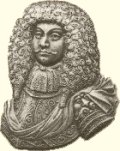 Georg (1626-99, to the left), Duke of Württemberg and Count of Mömpelgard (Montbéliard in nowadays France), was born on October 5, 1626, around noon, as a younger son in a minor branch of the German House of Württemberg. He was only 4 years old when his father, Ludwig Friedrich (1586-1631), died. It was the era of the devastating 30-Years-War, and George, his mother and elder half-siblings were forced to flee Mömpelgard multiple times. As he grew up,
Georg (1626-99, to the left), Duke of Württemberg and Count of Mömpelgard (Montbéliard in nowadays France), was born on October 5, 1626, around noon, as a younger son in a minor branch of the German House of Württemberg. He was only 4 years old when his father, Ludwig Friedrich (1586-1631), died. It was the era of the devastating 30-Years-War, and George, his mother and elder half-siblings were forced to flee Mömpelgard multiple times. As he grew up,  Georg spent many years in France. There, in 1648, he met and fell in love with pretty Countess Anna de Coligny (1624-80, to the right). When he married her on April 29, 1648, his family regarded the marriage as a mesalliance, because
she wasn't a Princess1.
Born on September 4, 1624, around 15:30, in the castle of Châtillon-sur-Loing, Anna was the youngest child of Count Gaspard III de Coligny (1584-1646) and his wife Anne de Polignac (1598-1651). In her youth Anna de Coligny had already exhibited some strange behavior. Once she had some sort of seizure, and tried to climb like a cat against the tapestries on the wall.
Georg spent many years in France. There, in 1648, he met and fell in love with pretty Countess Anna de Coligny (1624-80, to the right). When he married her on April 29, 1648, his family regarded the marriage as a mesalliance, because
she wasn't a Princess1.
Born on September 4, 1624, around 15:30, in the castle of Châtillon-sur-Loing, Anna was the youngest child of Count Gaspard III de Coligny (1584-1646) and his wife Anne de Polignac (1598-1651). In her youth Anna de Coligny had already exhibited some strange behavior. Once she had some sort of seizure, and tried to climb like a cat against the tapestries on the wall. When she was 21 years old, Anna’s father died. Shortly afterwards, Anna seems to have had some sort of secret affair with a Marquis de Vineuil, and, for a while, her mother feared for a pregnancy. Thus, Anna was taken to Belfort to live with her sister Henriette (1618-73). It was in Belfort that Anna met Georg of Württemberg.
After their marriage, Georg and Anna lived at castle Horburg. From 1650 onwards Anna gave birth to 5 daughters and 3 sons. The 2 eldest sons died young. The youngest daughter, Hedwig, was born in 1667 in Mömpelgard. Finally, in 1670 the long-awaited son and heir, Leopold Eberhard, was born.
In 1662, after his half-brother had died childless, Georg became reigning Duke of Mömpelgard as Georg II. Georg was a Lutheran, who read daily in the bible, while his wife Anna was a fanatic Calvinist. After Georg had tried to convert his wife to Lutheranism around Christmas 1662, the marriage soon deteriorated. Around that time Anna's mental health began deteriorating, too. Gradually, Anna was to become mad.

 One of their daughters, Eleonore Charlotte (1656-1743, to the left), was courted in 1670 by a relative, Duke Silvius Friedrich of Württemberg-Oels (1651-1697, to the right). They exchanged letters for a while until they were married in 1672, when she was 15. At first the marriage was happy, although it saddened Eleonore Charlotte that she remained childless. More and more, however, her husband suffered from a nervous state. He displayed unpredictable behavior, and sank into a state of complete dependence on his wife. As a
One of their daughters, Eleonore Charlotte (1656-1743, to the left), was courted in 1670 by a relative, Duke Silvius Friedrich of Württemberg-Oels (1651-1697, to the right). They exchanged letters for a while until they were married in 1672, when she was 15. At first the marriage was happy, although it saddened Eleonore Charlotte that she remained childless. More and more, however, her husband suffered from a nervous state. He displayed unpredictable behavior, and sank into a state of complete dependence on his wife. As a In 1676 Mömpelgard was occupied and partly destroyed by the French, and Georg and his family had to flee. In 1679 the Ducal family was able to return to Mömpelgard. The next year, however, the French occupied it again. From then until 1698, the family stayed mainly in Oels with George's daughter Eleonore Charlotte, who was to spend too much money to keep up appearances for herself, her father and her siblings.
Anna de Coligny died mentally incapacitated on January 13, 1680, around 14:00 in the castle of Reichenweier. Her mad eldest daughter, Heinrika (1654-1680), became so overwrought that she took to bed and refused all food. She died 10 days later. Anna was interred in the crypt of the castle church of St. Maimboeuf on March 8, Heinrika the day after.
 After their mother’s death, Eleonore Charlotte took care of her younger sisters, and tried to marry them off. She only managed to do so with Elisabeth (1665-1726). She was married at the age of 24 to a relative, Duke Friedrich Ferdinand of Württemberg-Weiltingen (1654-1705, to the right with his wife). She gave birth to 2 daughters and a son, who died young. In the summer of 1696 Elisabeth, too, became melancholic first and then incurably mad. She was locked up
After their mother’s death, Eleonore Charlotte took care of her younger sisters, and tried to marry them off. She only managed to do so with Elisabeth (1665-1726). She was married at the age of 24 to a relative, Duke Friedrich Ferdinand of Württemberg-Weiltingen (1654-1705, to the right with his wife). She gave birth to 2 daughters and a son, who died young. In the summer of 1696 Elisabeth, too, became melancholic first and then incurably mad. She was locked upAnother sister, Anna (1660-1733), hoped for a marriage with a Count of Birkenfeld of the House of Wittelsbach2, but nothing came of it. Later she became mad, too, and was locked up and cared for in Blamont. Once she walked with a knife into the church, where she was seized by force by the clergyman. From 1701 onwards, Anna of Württemberg was allowed to live in Ostheim for more than 20 years. There, she surrounded herself with dogs, cats and weasels. When one of her dogs died, she had it interred in a magnificent mausoleum, especially build for her dogs. Thus, she became known as “The Dog Princess”. After she had the clock of the town hall removed, because it made too much noise to her liking, and refused to return it, Anna had to return to her brother in Mömpelgard.
The youngest of the sisters, Hedwig (1667-1715), was for a short time engaged to King Karl XII of Sweden (1682–1718). Her whole life she remained convinced they were still engaged. She continued to write him love letters that were never send. Once she walked around in the park without proper clothing, shouted after by passers by. Hedwig stayed mainly with her sister Eleonore Charlotte in Oels, where they both converted

The father of those strange Princesses, Anna de Coligny's widower Georg II of Württemberg (to the left), seems to have been a bit of a nerd. He usually wore simple clothes. Georg liked to spend time with learned men, like Descartes. He also read Tacitus. He was said to have read the whole bible at least 500 times during his life. He could read French, Hebrew, Greek and Latin. He corresponded with ex-Queen Christina of Sweden (1626-89), who was intelligent, moody and strange, too.
Georg obstinately refused to recognize the overlordship of France, so in the period 1684-98 Mömpelgard was administered by his cousin Friedrich Carl of Württemberg-Winnental (1652-98) until the Treaty of Ryswyck was signed. Then Georg and his only son were finally able to return to Mömpelgard. Georg survived his mad wife for 19 years and died, aged 72, on June 1, 1699, between 11 and 12 o’clock in the castle of Mömpelgard. He was interred on the 23th.
The only surviving son of Georg and Anna, Leopold Eberhard (1670-1723), was called “The dissolute” and “The most shameless libertine”. Being the long-awaited heir, he was thoroughly spoiled as a child. Around the age of 10, he still couldn’t read or write in either German or French, but his strange father had then decided to hire a teacher in the Arabic language.
Later, Leopold Eberhard had been placed under guardianship of the regent, Friedrich Carl of Württemberg-Winnental. Like him, Leopold Eberhard followed a military career in Austria. As an adult Leopold Eberhard turned out to be very short-tempered and irritable. During his life he was to behave unconcerned and unscrupulous.
Around 1693 Leopold Eberhard fell in love with a baker's daughter, Anna Sabina Hedwiger (1676-1735), whom he may have secretly and morganatically married, as he later claimed. She gave birth to 5 children. Later, Leopold Eberhard befriended Richard Curie, and started having sex with Curie’s 4 daughters: Henriette Hedwig (1675-1707), Polyxène (†1708), Sébastienne and Elisabeth Charlotte (1684-1733).
Leopold Eberhard persuaded Anna Sabina to take Henriette Hedwig as her lady-in-waiting. In 1700, after Anna Sabina had retired to the castle of Héricourt, Leopold Eberhard lived openly with Henriette Hedwig until her death. They had 8 children. In 1718 Leopold Eberhard decided to marry the last remaining sister, Elisabeth Charlotte, with whom he had 7 children. He repeatedly sent requests to the Emperor to legitimize his morganatic children,
In 1719 Leopold Eberhard flaunted conventions even more by incestuously marrying 2 of his children with Anna Sabina, Georg Leopold (1697-1749) and Leopoldine Eberhardine (1697-1709), to 2 of his children with Henriette Hedwig, Eleonora Charlotte (1700-73) and Carl Leopold (±1698-±1758).
When Ludwig Eberhard died of a stroke on May 25, 1723, around 20:00, the Duchy of Mömpelgard was claimed by a distant male relative.